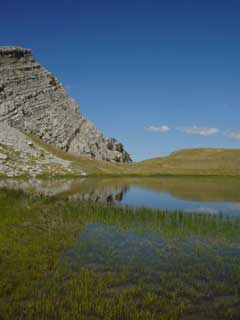- Regional water observation mechanism
- Regional Cooperation Assessment
- Water Quality Monitoring (JP)
- Water scarcity and drought (JP)
- Groundwater (JP)
- Waste water reuse (JP)
- Shared Water Resources Management (JP)
- Linking rural development and water management (JP)
- Waste management
- Water institutions
- Climate Change
- Floods
- Desalination
- Right to Water
- Irrigation
- Satellite data
- Water reports & data
- Hydrology
- Sanitation
- Gender and IWRM
- ArabWAYS
- Non-Revenue Water
- Virtual Water & Water Footprint
- WANA Water Panel
- Water Demand
- Water Governance
- Water Pricing
- Water accounts
- Water nexus Energy
- Geosciences
- Rural Management
 Classifying water bodies for flood risk management
Classifying water bodies for flood risk management
Climate change is expected to increase the intensity and occurrence of regional floods in Europe. A recent study has examined existing natural and constructed retention (or holding) basins that can be adapted to provide flood defences. As part of the study, a classification system for flood defence structures was developed to help Member States design sustainable flood risk management plans.
The EU's Floods Directive came into force in 2007 and requires Member States to conduct an initial assessment of water bodies (river basins and coastal areas) at risk of flooding by 2011. They are required to establish flood risk management plans by 2015.
This study on Sustainable Flood Retention Basins (SFRB) was undertaken as part of the EU-funded project Strategic Alliance for integrated Water management Actions (SAWA). Most SFRB are either engineered structures, such as (drinking) water reservoirs, or wetlands that can be used in sustainable flood risk management by potentially contributing to sustainable drainage. The researchers adapted characteristics used to classify SFRB in Baden, Germany in an earlier project for SFRB in the UK.
The researchers classified 167 water bodies in central Scotland, UK, capable of being used for flood management or diffuse pollution control according to their engineering features, and their landscape and catchment characteristics. Sites were surveyed in two stages: 39 characteristics used to classify water bodies in Scotland were first identified, and then sites were visited to document the water body inflows and outflows. The characteristics, such as length and height of the dam, outlet arrangement and operation, and site elevation, were chosen to be accurate, easy to obtain and reliable.
The analysis indicated that there are two main types of Scottish SFRB: 'Traditional Flood Retention Basin' (52 sites), dominated by former drinking water reservoirs, and 'Natural Flood Retention Wetland' (61 sites), such as natural lakes and large ponds, chiefly used for environmental protection and recreational purposes. In comparison, six distinct types of SFRB were identified in Germany, and it may be that flood infrastructure is under-developed in Scotland.
Many of the former water supply reservoirs in Scotland now serve multiple purposes, including recreation, nature conservation and angling. These sites could be used for flood control purposes if changes were made to how they were managed.
For example, many reservoirs are currently filled to their maximum volumes with water continually released down spillways. If heavy rainfall was anticipated, valves at these sites could be opened to release water and then closed before the rainfall event. This would enhance the holding capacity of reservoirs in the upper reaches of a catchment area, slowing peak flows and reducing the potential of flooding downstream.
Using The SFRB Concept would be a low-cost option in catchment-based flood control. Compensation would need to be paid to owners of the reservoirs, and where reservoirs are used for fishing, methods would need to be put in place to ensure fish were not lost when the gates are opened and the water is released.
| Creator | email: m.scholz@ed.ac.uk |
|---|---|
| Type of document | Report |
| Rights | Public |
| File link | n/a |
| Source of information | EC DG ENV / McMinn, W.R., Yang, Q., Scholz, M. (2010) Classification and assessment of water bodies as adaptive structural measures for flood risk management planning. Journal of Environmental Management. 91(9):1855-1863. |
| Keyword(s) | EU's Floods Directive, flood risk management, climate change, natural hazards |
| Subject(s) | no translation available , no translation available , no translation available , no translation available |
| Relation | http://www.northsearegion.eu/ivb/projects/details/&tid=86 |
| Geographical coverage | Europe |
 you are not logged in
you are not logged in





